
Vân-Ánh Võ
Meaningful Conduits
by Anil Prasad
Copyright © 2015 Anil Prasad.
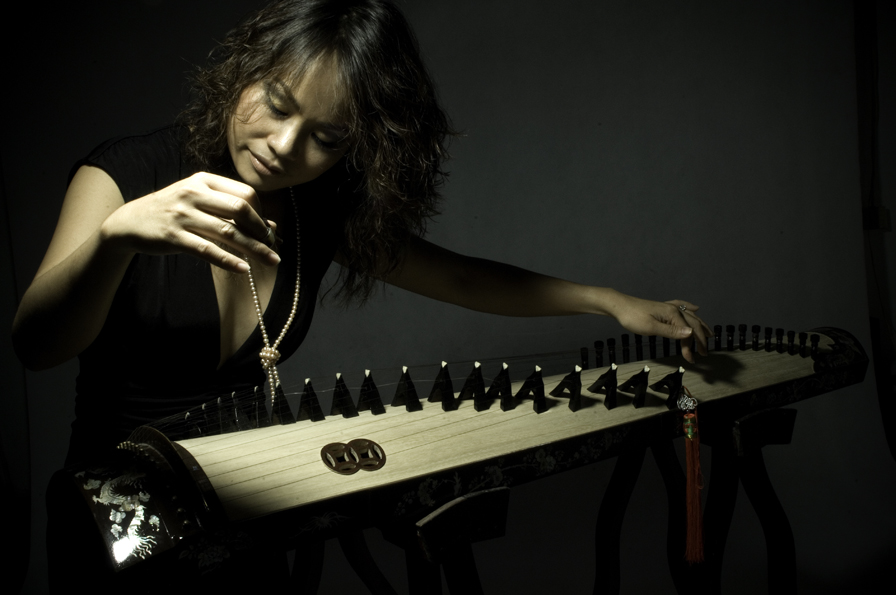
Every day has the potential to unveil a new aural revelation for Vietnamese multi-instrumentalist, composer and vocalist Vân-Ánh Võ. She’s one of Vietnam’s foremost traditional musicians, having won the country’s national championship for her performances on her core instrument, the dan tranh, a 16-string zither. Since relocating from Vietnam to Northern California in 2001, she has embraced the expansive diversity of the region’s musical possibilities and integrated them into her own vision.
Võ has worked on soundtracks for acclaimed films such as Daughter from Danang, Bolinao 52 and A Village Called Versailles. She has also collaborated extensively with Kronos Quartet on two major productions, “All Clear” and the forthcoming “My Lai.” In addition, Võ has struck up a partnership with fellow boundary-breaking Vietnamese musician Nguyên Lê. They continue to perform together and collaborate in multiple contexts. The same holds true for her output with percussionist PC Muñoz and cellist Alex Kelly, who she’s joined forces with in her new VA’V Trio, which explores the intersections between Vietnamese music, jazz, rock, and classical. Muñoz and Kelly also figure prominently in Võ’s “Fire and Bronze” group, which bridges ancient Vietnamese musical influences going back to 200 BC with contemporary Vietnamese and Western sounds. Yo-Yo Ma recently took an interest in Võ’s explorations as well, resulting in her performing with his Silk Road Ensemble on the soundtrack for The Vietnam War, Ken Burns’ forthcoming documentary.
Võ is in the midst of creating her biggest project to date, "The Odyssey—From Vietnam to America,” a 45-minute multimedia piece that explores the lives of the million-plus Vietnamese “boat people” who fled to the US to escape the turmoil of violence, oppression and poverty, and establish new possibilities for their families. The project is partly funded by a grant from the San Francisco-based Creative Work Fund, as well as a co-commission from the Yerba Buena Center for the Arts. “The Odyssey” will be presented by the Kennedy Center for its East Coast premier in March 2016.
Three-Mountain Pass, Võ’s latest album, is another showcase for her borderless approach. In addition to performing on the dan tranh, the album finds Võ playing the single-stringed dan bau, the 36-string hammered dulcimer known as the dan tam thap luc, and a bamboo xylophone called the dan t’rung. The album is rooted in Võ’s personal take on traditional Vietnamese music from across the North and South, but also includes a reinvention of Erik Satie’s “Gnossienne No. 3” and a chamber music-influenced collaboration with Kronos Quartet on “Green River Delta.”
Three-Mountain Pass represents a significant evolution for you. Describe what you sought to achieve with it.
The idea was to make my first album that contains music I either composed or arranged myself. It was a very interesting and exciting idea for me. On my previous two albums, I performed many different kinds of music, but it was always music that someone had written for me. Three-Mountain Pass has seven pieces on which I play dan tranh, dan bau, dan trung, and percussion. It also has some vocals. I think it’s my first project in which listeners can really experience the many aspects of what I’m doing. During the process, David Harrington suggested that Kronos Quartet perform as a guest on the CD, which was an honor. I also wanted to include a piece from beyond Vietnam, which is why I performed “Gnossienne No. 3” by Erik Satie on dan bau and bass dan tranh on the album.
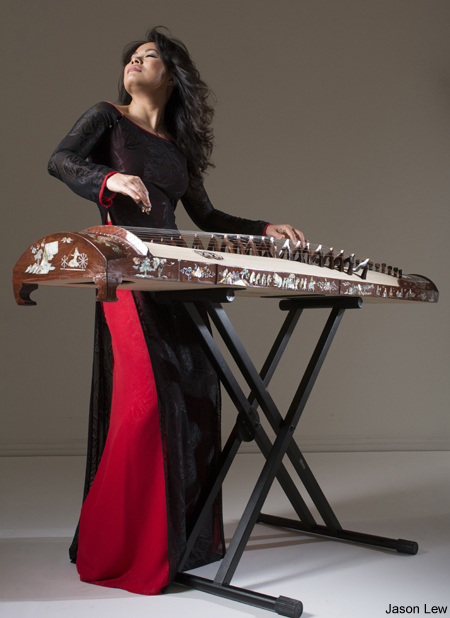
The album begins with “Vong Co,” a solo dan tranh piece dedicated to your teacher, Master Nguyen The Thiep. I understand it holds great meaning for you. Tell me what it communicates.
I’ve been very lucky to have apprenticed with six different masters for different Vietnamese music genres. Master The Thiep taught me this piece, which is a very famous composition used in Southern operas. The song is very important to me.
It took three years for Master The Thiep to decide to accept me as his student. I first approached him in 1988, but it was only in 1991 that I was accepted. The master-apprentice relationship in Vietnam means you become just like a family member. I literally found myself doing all of the household chores required in order to earn his trust. Once I had his trust, he shared all of his knowledge with me and cared for me like his own daughter. It was important to him because his children didn’t want to learn the music and he gave up hope of his children carrying his tradition forward. “Vong Co” was one of the pieces he taught me. I performed that song in the Vietnam National Championship competition for the dan tranh and won first prize.
There are many reasons I wanted to dedicate the piece to him. In addition to him being such an important teacher and great inspiration, something very sad happened. One day, I was going to study with him. I was on my way and he was lying in his bed, which he also used as a teaching table. The tea set was ready and the water for the tea was hot. The instruments and music were all set for our session. But he passed away just an hour before I arrived. I was shocked. It was a big loss to me and my family. I couldn’t believe he passed away just like that. It made me really want to honor him.
Describe how you collaborated with Kronos Quartet on “Green River Delta” from the album.
It’s a traditional piece composed by one of my masters, Kim Sinh. It’s from a Southern Vietnamese opera. The idea of using Kronos Quartet to present the piece was a very interesting idea. David Harrington and I listened to many pieces and decided this one would work the best for the group. Everyone in Kronos was very interested in adapting their instrument’s sound to work in the piece. For example, John Sherba, the second violin player, used a stick, pencil or chopsticks to see if he could make a sound like the nylon moon-shaped two-stringed lute called the dan nguyet. Jeffrey Zeigler, Kronos’ cellist at the time, wanted to see if he could make his cello sound more Vietnamese by using a sea tortoise-shell pick on his instrument. David used a paper clip to clip strings together to make his violin sound like a Vietnamese violin. I also helped him and the rest of the group learn how to bow their instruments to get Vietnamese-like sounds with the proper vibrato. I explained to the group that the most important thing about Vietnamese music is the left hand. You really have to know what to do with the left hand in order to really reveal the colors and characteristics of the piece. It’s the soul of the music. If you use vibrato incorrectly, you could turn a Southern opera piece into a Northern one with a single note. After I worked on the arrangement with them, I added my own part to it. We premiered it in 2012 at the London Olympic Music Festival. It was the group’s first collaboration with a Vietnamese musician and the crowd went nuts because it was so special and new.
After we recorded it, I set up a Skype meeting with Kim Sinh, who is blind. I was in Vietnam with him and David was in San Francisco. It was the first time I had my master listen to a piece David and I worked on together. It was very tense for David because he wanted to see how my master would react. His reaction could have been very good or very bad and whatever it was, we were going to have to deal with it. But as it started, my master smiled all the time but didn’t say anything, which really worried David. My master then turned to me and asked “Was that four American guys with black hair and yellow skin? It sounds like Vietnamese people playing it. They did a perfect job.” [laughs] David was super happy. He ended up including the piece on the recent Kronos collection A Thousand Thoughts, which was great.
What initially drew you to the dan tranh as your core instrument and focus?
I started learning music when I was four. My father was a musician who played Western classical guitar. He was my first teacher and taught me to read and practice music. I was reading music at age four, but didn’t start learning an instrument until age six. My father said “Let’s learn the cello.” As a girl, I thought “It looks ugly to me. It’s also big. I don’t want to play an instrument with my legs open, either.” He said “Okay, let’s see what you like.” One day, I saw a lady playing the dan tranh and I said “That looks beautiful. Can I study that instrument?” My father agreed and I learned it without my parents asking me to practice. I wouldn’t go out and play with children. I would just get my instrument and practice. It felt very natural.
Later, I attended the National Academy of Music in Hanoi. When I studied there, I never went camping or on field trips. I wanted to save all my time for the instrument. The more I learned about it, the more I realized it could help express so many different states of emotion. When I’m really upset, I can pick up the dan tranh and people will know. You can make the dan tranh sound like a drop of rain, a water splash, ocean waves, or a giant storm. It can be so quiet, peaceful, loud, and everything in between. The dan tranh can also be used to accompany so many different musical genres in Vietnam. It can be used for opera, as an accompaniment instrument or a solo instrument.
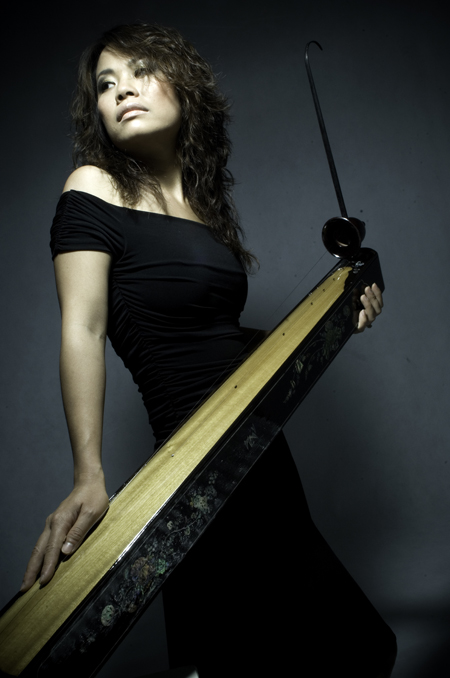
Your other key instrument is the dan bau. For a Westerner, the idea of a single-string instrument is largely alien. How do you modulate the string to make such expressive sounds?
The dan bau was designed by a street beggar in the 9th Century. It wasn’t accepted by higher-class people, including the King and Queen. They held court music concerts that required eight different instruments. Dan bau wasn’t included because it was a low-class street instrument. However, the instrument is remarkable because it’s so similar to the human voice. It can bend up and down just like if you’re singing. That’s why people can’t resist listening to it. We even have a saying in Vietnam that goes “If you’re a lady, you should not listen to the dan bau because you will fall in love with the man playing it.” The sound has that much of an attraction. Parents would even warn children not to listen to the instrument because it can cast a spell.
The sound of the dan bau is so dominant that it can’t accompany other instruments because it would take away the attention from them. Even though the dan bau possesses a powerful and emotional voice, the instrument’s structure is actually very simple. You tie a string to a bamboo stick on one end and to a buffalo horn on the other. Together, it’s very flexible and you can bend from one note down for one-and-a-half octaves and bend up to another octave. So you can move within two octaves using a single note. The sound also sustains a lot. You have to use different harmonic methods to pluck to create variations in sound, but otherwise the instrument has one pitch regardless of where you pluck. Also, the expression of the music depends on the player, not on the composition itself.
Were you able to get exposed to any non-Vietnamese music while growing up in Vietnam?
No, I didn’t get to hear anything other than a little music by ABBA in the mid-‘90s. The country was entirely closed to outside influences. Music couldn’t even be smuggled in. If it was and you were caught listening to it, you would be in trouble. My family didn’t even have a cassette player and that was in the ‘90s. Can you believe it? Everyone was so poor. In 1995, things started to open up, but before then I didn’t even know what a CD looked like. We didn’t have a phone. We wore the same color clothing every day. Every family would get three kilograms of fish, two kilograms of meat, and five cans of condensed milk for the whole month. We would also get 10 kilograms of rice for each person and that was it.
In 1995, after the US lifted the embargo against Vietnam, the Vietnam government sent a group of musicians to the States. They did this because they felt music would have nothing to do with politics and that it would be a peaceful gesture. I was chosen to be one of the musicians and it was a real honor. I was one of only 20 people in 20 years to come to the US. It was the same year I won the National Championship. I was 21. From that point, I was able to travel outside of Vietnam and hear more music from around the world. When I first traveled to the US, I met my husband who was a volunteer that was hosting the group. We became friends for five years, and after that, got married. Then I moved to America in 2001.
At what point did you realize you wanted to integrate what you do into other world musics?
It was something on my mind for a long time, but there was no way I could do it when I was in Vietnam because everything was censored. Every single song was something I was asked to play because it followed a specific direction or program. I also had to earn a living. So, while in Vietnam, I didn’t compose any music because I didn’t have a need to.
It’s interesting. When I moved to America, I wanted to quit doing music. I thought “What’s the point of doing it when everything I do is related to following orders from someone telling me what to do?” I stopped performing. I saw live music, but from 2001 to 2003, during my first years in America, I only played my instrument privately at home. I worked in human resources for an American company with a presence in China. I felt I had enough of performing what people wanted me to perform instead of what I wanted to do. My husband encouraged me to keep going. I started to realize that I should compose my own songs and integrate my own thinking into them. He planted the idea of me doing my own projects that are highly artistic instead of commercial.
What were your key projects when you chose to become a working musician again?
In 2003, I was asked to co-compose and record music for the documentary Daughter from Danang, which was nominated for an Oscar. I recorded all of the Vietnamese instruments for it. The producer was interested in my contributions because she didn’t know anything about Vietnamese music. In 2007, I also worked on a film called Bolinao 52 which won the 2009 Emmy award for its soundtrack. The film’s director, Duc Nguyen, really needed some help with the traditional Vietnamese music side and asked me to contribute. I went on to co-compose music for a documentary named A Village Called Versailles, which came out in 2009. It’s about how the New Orleans Vietnamese community was affected by Hurricane Katrina. They were left out of the rebuilding plans and their community’s land was used as a dump site for all of the trash from the disaster. The film deals with their struggles in a very emotional way.
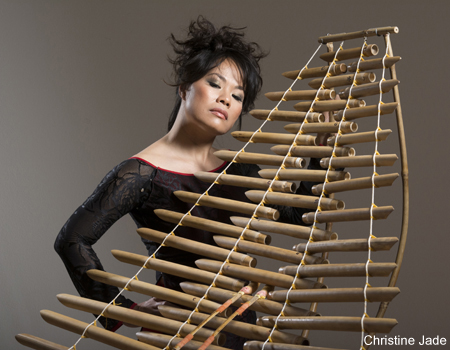
I understand Nguyên Lê inspired you to pursue live performances once you were based in the States.
That’s true. One of the people involved in the National Competition I was a part of in 1995 was Dr. Tran Van Khe, who was also an advisor for Nguyên. He is a friend of Nguyên’s parents. When Dr. Khe heard my music, he said he thought I should know Nguyên because there was something unique about it. So, that’s how I came to know of Nguyên. When I first listened to his music I thought “This is exactly where I’d like to go with music. It has a strong Vietnamese identity, but it’s so open to other cultures.” So, I followed his music. In 2004, Nguyên was invited to perform in Orange County. One of the organizers arranged for me to play with Nguyên at this event, but Nguyên already brought over his band of Vietnamese musicians, including a dan tranh player, so it didn’t make sense for me to be a part of it. I wasn’t in the mode of playing live. But the organizer did give Nguyên one of my CDs.
Then in November 2009, Nguyên came to play at Yoshi’s in Oakland with his Saiyuki trio. I emailed Nguyên and told him I’d like to introduce myself. He wrote back and said “I remember you. I have your CD. Please come and meet me at Yoshi’s.” So, I came to the show, we talked, and I helped him sell CDs after the show.
In 2010, I actually started to work with Nguyên. He came back to the San Francisco area and asked me to bring my instrument to play for him. I played my own song and showed him that I wanted to do things in a non-traditional way. Nguyên didn’t say much other than “You sounded very traditional.” I was very sad but thought that at least I tried. However, a few months later Nguyên called me and said he wanted to explore the idea of working with me and arranging music together. I was so happy. He’s such a great musician. I decided to organize a concert in Oakland and we performed together live for the first time. The concert really pushed me to learn his very complex material. Later in 2010, I met Kronos Quartet, so it was an amazing year that has led to so much amazing music and really incredible projects.
What was it like to work with David Harrington of Kronos Quartet on "All Clear?"
Working with David is great because he’s very detail-oriented and cares a lot about making statements through music. Every single thing has to have meaning. When you collaborate with him and the group, you’re forced to think deeper and go further than you have before. They’re also open to suggestions. If you can prove your point about how a piece should work, they’ll listen and go with it. Working with Kronos has really made me think about how I present my music in new ways.
How did you first connect with Kronos Quartet?
I’ve been a fan of Kronos for a long time. I fell in love with the way they present music and their open-minded perspective. It’s so far ahead of most musicians. They think of things before others think of them. They dare to do things before others dare to do them. In 2010, I went to a concert of theirs at Stanford University and after the show I wanted to thank them in person. They had just performed “WTC 9/11” by Steve Reich. I waited after the show and Jeff Zeigler came out. I discussed my thoughts about the show and said I’m also a musician and Vietnamese. He said “You should talk to David.” He led me to the green room and introduced me. We talked for a little while and David said we should meet later. That’s how things began.
In just one year, you went from a random meeting with David to “All Clear,” a large-scale conceptual work with the group. Describe the rapid progression that led to it.
When David talked to me, he said that Kronos has been interested in working with the music of Vietnam for a long time. David also told me he started Kronos as a reaction to the Vietnam War and that they were always looking for a musician like me that had traditional training, but could also work with Western musicians. The more we talked, the more I shared about my background. He owns around 50 CDs from Vietnam, which is amazing. A lot of those albums can’t even be found in Vietnam. I knew almost every single artist and CD, so he was able to learn a lot more about the music he already had through me, as well as Vietnamese culture in general. The project moved quickly because everyone was so enthusiastic about creating something that connected our two worlds of music.
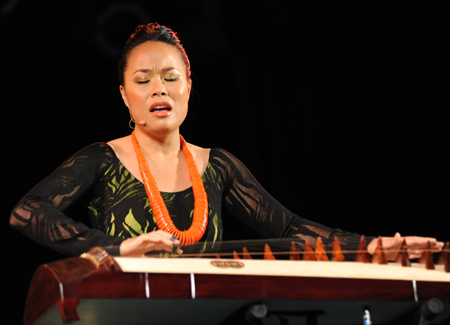
Harrington told me you were the first musician that truly understood his feelings about the Vietnam War. Why do you believe he felt that way?
I think it’s related to the fact that I’m a Northerner from Hanoi. My father was drafted and fought in the French War and then the American War. I grew up hearing all of the good and bad stories from the North. When I married my husband, who comes from South Vietnam, and I moved to America in 2001, I heard so many additional stories from the South. I could understand both sides and the scars everyone had. In Vietnam, we lived under a government system in which you had no choices. You were drafted and you went. In a way, it was just a job. It meant your family got food to eat. If you didn’t go, you were betraying your country and put your family in trouble.
What I’ve also come to understand is that the fundamental nature of human beings is that we love each other. We don’t hate each other. We don’t have built-in conflict. But when we are forced to choose between protecting your family or putting it in danger, then people make up their minds and sometimes decide to engage in war. In the end, it’s the governments that make these things happen, not the people. So, I listened to stories of the aftermath and saw how poor people were and how precious things were as a result. It was interesting to talk to people from South Vietnam in America. People assumed that when the North took over the South that we became kings and queens. No. We still lived under a lot of fear. It has been fascinating to share stories with my Southern friends and establish a shared understanding of how we were all affected by war.
Provide some insight into what you wanted to communicate with “All Clear.”
I want to create music that is beyond pure entertainment and Kronos feels the same way. When they asked me what I wanted to do in collaboration, I said “It’s a very complex thing that involves me wanting to express the voice of regular civilians.” For instance, the war affected me and my family terribly. My sister was born during Christmas of 1972 in the midst of the heaviest bombing. For 12 days, Hanoi was bombed continuously. My mother told me she remembers having to hold my sister as she jumped in and out of a bunker on the side of a street to keep her safe from the bombs. Rain fell very hard during this period and the bunker was flooded and many people drowned in it. So, the experience of war is very personal.
The title “All Clear” is very important. The Vietnam War scarred a lot of people, Vietnamese and Americans alike. We chose the name because now, we look back and understand that very bad things happened during the war, and we don’t ever want to get into a war like that again. We shouldn’t forget what happened either. However, most of what Americans know about Vietnam is because of the war. Television and radio covered it, and what they focused on are sad, painful things. They didn’t tell people about our heritage of 4,000 years and the beauty in our traditions, music and literature. They don’t know about the hidden beauty of our traditions. With “All Clear,” I wanted to give the audience the opportunity to learn about those things.
Creating “All Clear” with Kronos felt very natural. We spoke for seven months before they asked me to compose something for them. I wrote the first version of the piece, gave them a mock-up, and they got right back to me with their thoughts. It’s inspiring to work with them. The ideas just pour out of you. We discussed and exchanged ideas in a very positive way. I feel lucky to have the chance to work with Kronos. They really gave me an opportunity to share things from the bottom of my heart, and encouraged me to pursue total freedom of expression.
For “All Clear,” I spent two months in Vietnam, going from North to South, interviewing everyone I could for the piece, from people on the street, to those in the rice fields. When you work with Kronos, you really want to explore things in a significant way. You want to understand the topic matter strongly and ensure you feel totally confident about it. I also included the poetry of Ho Xuan Huong, a provocative female poet from the 18th Century who dared to use the female body in her poetry to express her thoughts about the world around her.
One of my goals was to ensure Vietnamese people of all walks of life were represented. It’s something I felt important because it wasn’t that long ago that I was experiencing discrimination, including right here in America because of my background. In 2009, I applied for a grant and I was turned down because a panelist was upset that I graduated from the National Academy of Music in Hanoi. The panelist said I was using music to spread Communism. It was unbelievable. The panelists had to list their reasons for their decision and that was it. I protested and reapplied in 2010. That panelist was no longer a part of the process and I got the grant the next time, so it worked out.
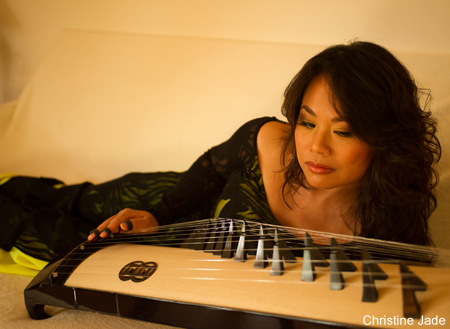
Tell me about “My Lai,” the new production you’re working on with Kronos.
It’s a collaboration with Kronos and the composer Jonathan Berger from Stanford University. Jonathan proposed to Kronos that they do an opera about the My Lai Massacre in Vietnam in 1968. It’s about when Charlie Company went to My Lai and 500 civilians were killed. But the opera isn’t about that, specifically. It’s about the helicopter pilot who tried to stop Charlie Company from shooting innocent people. He couldn’t, but what he did was save a few children that he could pick up and bring to his helicopter. He then flew them out of My Lai. The featured opera singer is Rinde Eckert, who is really great. The music includes Kronos, vocals, my instrumentation, and digitally-processed sounds. Jonathan had never written for non-Western instruments previously but was very enthusiastic when he listened to my music and understood what I could bring to the production. The debut will be at Stanford University in October 2015.
"The Odyssey—From Vietnam to America” is another major project you have in the works. Describe what it explores.
It’s a multimedia piece that explores the strength of the human spirit through the eyes of the "boat people" who fled oppression, violence and poverty after the war. Since I moved here, all of my Vietnamese friends are from the South. I listened to their own stories about what life was like. I interviewed 30 people for “The Odyssey” from different states in Vietnam. The pain people in the South had was bad too. Most of them don’t want to discuss it. They treat it as a period of time that disappeared from their lives as if it never happened.
One person who I interviewed left on a boat to come here with her three daughters in 1987. But her husband was in a concentration camp because he used to be the colonel of the old army. Her husband urged them to leave for the future benefit of their daughters. But their boat was very unlucky. It was captured by pirates in Thailand. The women were captured and placed on an isolated island. The pirates would come back night after night to rape the women. To protect her daughters from being raped, she poured black diesel all over them and had them play dead. One of her daughters almost died of suffocation from it, but she was okay in the end. These women were so brave. They finally got rescued by some fishermen.
Another person I interviewed had nine boys. During the war, the boys and her husband were all required to be enlisted for the army. None of them came back from the war. This woman has to deal with this for the rest of her life. All of her loved ones were gone. How one deals with that is one of the things I explore in the piece.
In my father’s case, he was the only male in the family, so he had to join the army. But he was a musician, so even though he couldn’t play music well, it was a way for him to get around without having to hold a gun. The alternative was for him to go into the battlefield. When both sides stopped shooting, he would cheer up the soldiers by performing. His perspective was that he might still get shot but at least he didn’t have to do the shooting.
For me, there were also simpler things I recalled like the fact that my school bell was made from a piece of a B-52 bomber. They would ring it every day for recess and it always served as a reminder of what happened. I didn’t question those things much when I was very young, but as I grew older, I realized how strange they were.
Vietnamese people are among the more recent immigrants to the United States and many of us have become quite successful. I think that strength is related to the struggles we had and the sacrifices we made. We are strong and stand tall like bamboo. There’s something in the human spirit to be admired and this is one of the important parts of what I look at in "The Odyssey."
What sort of music does “The Odyssey” focus on?
When people in Vietnam got into difficult situations, many of them would go back to the nursery rhymes and lullabies they had as children for comfort. We have 54 ethnic groups in Vietnam and each has its lullabies about mother and child, father and child, and wife and husband. They’re purely about love. They’re also very beautiful. There’s nothing scary like “Rockabye Baby” in the States. [laughs] Our lullabies are nurturing and are about the resilience of the human spirit. The music is based on a collection of lullabies from the different ethnic groups. I used the lullabies as raw material and built the music from there. I use my instruments, as well as Western instruments such as drums and percussion from PC Muñoz and cello from Alex Kelly.
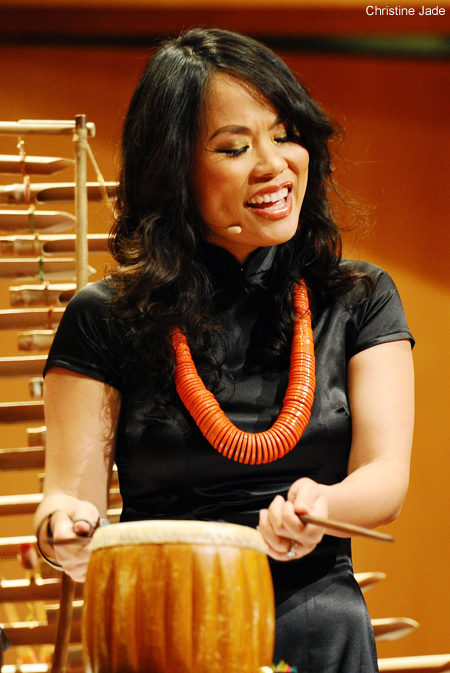
You’re bridging Vietnamese traditional music with rock and jazz in “Fire and Bronze,” which is both a group and conceptual construct. Tell me about it.
“Fire and Bronze” is about the fact that we have 4,000 years of cultural history in Vietnam and I want to share more of it with people outside of the country. It uses the elements of fire, earth, metal, water, and wood to inspire the compositions. The bronze drum is one of the first musical instruments we ever had in Vietnam from 200 BC. In addition to bringing new sounds into my music, I want to bring in traditional instruments but do new things with them. Because bronze drums are museum pieces, you can’t touch them or play them. All you can do is look at them. So, I had to have one made. I didn’t know what it would sound like, so I used my experience as a musician to inform its replication. I had it shipped here from Vietnam and first used it in “All Clear” and then in “Fire and Bronze.”
During the first “Fire and Bronze” performance in Southern California, a couple of people who have a private collection of bronze drums agreed to bring some of their instruments for an exhibit in the lobby before the show. They also let me touch a couple of the drums and I tapped them lightly and realized that the drum I had made sounded the same, which was a relief. The drums were fascinating, because the decorations, shapes and features would tell you what class it came from and what it was used for.
I’m in phase one of the “Fire and Bronze” project in that we’ve been mainly exploring the musical side. It will eventually become a theatrical piece. The initial performances included Nguyên Le, the bassist Aaron Germain, and the percussionist Jimi Nakagawa. Now, the project involves PC Muñoz and Alex Kelly. I hope to record the music in the future.
You also work with Muñoz and Kelly in the VA’V trio. What are you exploring with them in this format?
I always wanted to find musicians interested in really trying new things and both PC and Alex are those types of people. Alex is a really awesome, classically-trained cellist but can improvise like a jazz musician. He also plays banjo, piano, didgeridoo, and a bunch of other instruments. PC is a hardcore rhythm person who can play so many percussion instruments. I’m working with them on several other projects, but in the VA’V trio, we’re doing music that’s very different, improvisation-based, and contemporary. We’re using very modern sounds and it’s a group that’s free of forms. We’re currently making an album that includes a really exciting and innovative 20-minute long piece.
Hip-hop is another musical universe you’re involved with via Blood Moon Orchestra, along with Muñoz and MC Dem One. What appealed to you about this project?
Hip-hop is so different and very free and daring. Doing this project is another way for me to push my boundaries and get out of the comfort zone. I’d never say that I’m a hip-hop artist, but rather I’m someone who is always trying to find new things to explore. PC initiated the project. I told him I wanted to do something really different. He said “Let’s do hip-hop with Vietnamese instruments!” [laughs] I loved that. It was a very unique idea and PC knew Dem One, who is a great MC. We’re going to release a track in the near future. It turned out really well. The piece features loop-like playing from me that shifts and evolves as it goes along. We’ve done a video for it that we’re working on as well.
You recently worked with Yo-Yo Ma and the Silk Road Ensemble on the soundtrack for The VIetnam War, Ken Burns’ upcoming documentary. Tell me about that experience.
I was very honored to work with Yo-Yo Ma. The plan was to have Yo-Yo shadow my playing on the dan bau for a Vietnamese lullaby. Yo-Yo asked me to record several versions on my own so I could be free to improvise within the same theme. Two months later, I came to New York City and the whole team, including Yo-Yo, Ken Burns and the Silk Road Ensemble, gave me such a warm welcome.
Ken asked me about my experiences growing up after the war, the things I saw over there and Vietnamese people I know over here. When it was time to record, Yo-Yo asked to stay in my recording booth to watch my left-hand movements. He closely studied how I created the ornamentations that are unique to Vietnamese music. I never felt like it was Yo-Yo sitting down at the edge of the recording booth glass window. It felt like he was a musician friend I had known for a long time.
After a half-hour of watching my left hand and listening to my playing, Yo-Yo got his cello and started to play along with me. Amazingly, he could do all of the ornamentions, slice-ins, and vibratos—and made it sound very original. He was able to do it similarly to a Vietnamese person playing a Vietnamese fiddle instrument. Even though I’ve been working with many string players, especially cellists, I had never seen some of the creative techniques that Yo-Yo used to shadow me before. It was so inspiring to share the emotion and musical shifts in the music together. His sound was so sweet, warm, and creative, yet so honest. It made me want to open my heart more and pour as much soul into the music as I could. We worked together for four hours. He showed me how someone can be a wise musician using his own emotional language to win people’s hearts.
How did the opportunity to jam with Al Di Meola in 2010 emerge?
I went to see Al at Yoshi’s in Oakland in 2010. I saw that he has a very distinctive approach to his music. I wanted to know more about him. After the concert, I could see that he was a nice person to talk to. He met with lots of fans. I waited patiently and finally he saw me standing there and we discussed the fact that I play many different instruments and how impressed I was with his music. He said “Come to our Santa Cruz concert and bring your instrument.” I said “For what?” He said “Jam with me.” So, I went to Santa Cruz and brought the dan tranh. After the concert, he invited me backstage and we spent a whole hour jamming. It was recorded and is up on YouTube. We’ve stayed in touch ever since.
How does spirituality inform your music?
I want to make music that fits my soul and spirit. My role is to keep my family’s sense of spirituality alive in terms of being peaceful and healthy in the mind. I don’t mean spirituality in the sense of being religious. It’s about being good people. I respect people of all different religions, but you don’t have to go to a church to be a good person. You simply need to be a good person. Making music that people understand and relate to is part of this for me, too. I think a good piece of music can live for a lifetime and be accepted by people in many different walks of life. When I make music, I want Vietnamese people to be proud of it and not question whether I am from the North or the South. I want them to see themselves in my music regardless of where they come from.
There’s another element of spirituality I have been involved with. We have a tradition in Vietnam of musicians who serve as a conduit with the dead. This is called Len Dong music. It is a specialty of one of my masters. Typically, this music is played by men. He once took me to a Len Dong ritual and people wondered if I was qualified. However, because I had conservatory training, the way I interpreted the music was different and people found it interesting, and they wanted me involved.
The music lasts for seven to 10 hours non-stop. You barely have time to get up and go to the restroom. During the ritual, someone is assigned to communicate with the dead. If you are a man that wants to connect with the dead, it will be a woman and vice-versa. I did Len Dong music for seven years. I saw that music could be a real comfort for people. It was very important to us and the families. It was always fascinating for me and I wanted to dig deeper.
I really believe there is a connection between the living and the dead. Somehow, everything comes together in that ritual. People from different times are connected. I think the music is definitely reaching the dead. I always believe music has to be very honest. We are people who help people reach their relatives who have passed away. We play music but we’re not musicians. We are tools that help other people.